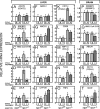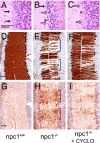Reversal of defective lysosomal transport in NPC disease ameliorates liver dysfunction and neurodegeneration in the npc1-/- mouse
- PMID: 19171898
- PMCID: PMC2650164
- DOI: 10.1073/pnas.0810895106
Reversal of defective lysosomal transport in NPC disease ameliorates liver dysfunction and neurodegeneration in the npc1-/- mouse
Abstract
Niemann-Pick type C disease is largely attributable to an inactivating mutation of NPC1 protein, which normally aids movement of unesterified cholesterol (C) from the endosomal/lysosomal (E/L) compartment to the cytosolic compartment of cells throughout the body. This defect results in activation of macrophages in many tissues, progressive liver disease, and neurodegeneration. In the npc1(-/-) mouse, a model of this disease, the whole-animal C pool expands from 2,082 to 4,925 mg/kg body weight (bw) and the hepatic C pool increases from 132 to 1,485 mg/kg bw between birth and 49 days of age. A single dose of 2-hydroxypropyl-beta-cyclodextrin (CYCLO) administered at 7 days of age immediately caused this sequestered C to flow from the lysosomes to the cytosolic pool in many organs, resulting in a marked increase in cholesteryl esters, suppression of C but not fatty acid synthesis, down-regulation of genes controlled by sterol regulatory element 2, and up-regulation of many liver X receptor target genes. There was also decreased expression of proinflammatory proteins in the liver and brain. In the liver, where the rate of C sequestration equaled 79 mg x d(-1) x kg(-1), treatment with CYCLO within 24 h increased C movement out of the E/L compartment from near 0 to 233 mg x d(-1) x kg(-1). By 49 days of age, this single injection of CYCLO resulted in a reduction in whole-body C burden of >900 mg/kg, marked improvement in liver function tests, much less neurodegeneration, and, ultimately, significant prolongation of life. These findings suggest that CYCLO acutely reverses the lysosomal transport defect seen in NPC disease.
Conflict of interest statement
The authors declare no conflict of interest.
Figures





Comment in
-
Unraveling the sterol-trafficking defect in Niemann-Pick C disease.Proc Natl Acad Sci U S A. 2009 Feb 17;106(7):2093-4. doi: 10.1073/pnas.0812934106. Epub 2009 Feb 11. Proc Natl Acad Sci U S A. 2009. PMID: 19211789 Free PMC article. No abstract available.
References
-
- Carstea ED, et al. Niemann-Pick C1 disease gene: Homology to mediators of cholesterol homeostasis. Science. 1997;277:228–231. - PubMed
-
- Naureckiene S, et al. Identification of HE1 as the second gene of Niemann-Pick C disease. Science. 2000;290:2298–2301. - PubMed
-
- Liu B, Xie C, Richardson JA, Turley SD, Dietschy JM. Receptor-mediated and bulk-phase endocytosis cause macrophage and cholesterol accumulation in Niemann-Pick C disease. J Lipid Res. 2007;48:1710–1723. - PubMed
-
- Blanchette-Mackie EJ. Intracellular cholesterol trafficking: Role of the NPC1 protein. Biochim Biophys Acta. 2000;1486:171–183. - PubMed
-
- Xie C, Turley SD, Pentchev PG, Dietschy JM. Cholesterol balance and metabolism in mice with loss of function of Niemann-Pick C protein. Am J Physiol. 1999;276:E336–E344. - PubMed
Publication types
MeSH terms
Substances
Grants and funding
LinkOut - more resources
Full Text Sources
Other Literature Sources
Medical
Molecular Biology Databases

